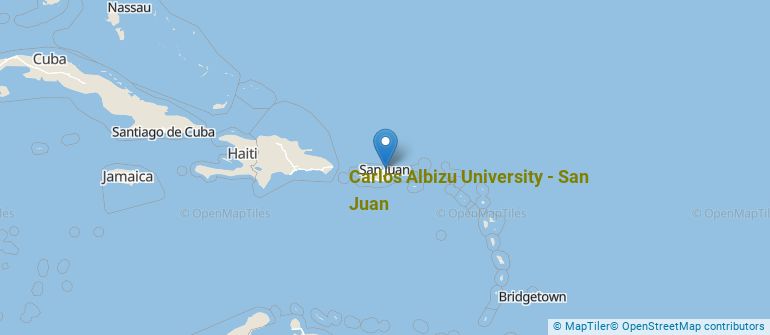 by our College Data Analytics Team
by our College Data Analytics TeamExplore the best ranked schools for the programs you are most interested in.
Carlos Albizu University - San Juan was not ranked in College Factual's 2025 Best Overall Colleges report. This could be for a number of reasons, including lack of data.
See all of the rankings for Carlos Albizu University - San Juan.
Because it has a high acceptance rate of 100%, some consider Carlos Albizu University - San Juan to be a safety school. But don't just assume that admittance is in the bag. Make sure to spend enough time on your application so that it is in tip-top shape.
The student to faculty ratio is often used as a measure to gauge how much access students will have to their professors - the lower the number, the better. At Carlos Albizu University - San Juan, this rate is 21 to 1, which is high when compared to the national average of 15 to 1.
Another measure that is often used to estimate how much access students will have to their professors is how many faculty members are full-time. The idea here is that part-time faculty tend to spend less time on campus, so they may not be as available to students as full-timers.
The full-time faculty percentage at Carlos Albizu University - San Juan is 23%. This is lower than the national average of 47%.
The freshmen retention rate of 77% tells us that most first-year, full-time students like Carlos Albizu University - San Juan enough to come back for another year. This is a fair bit higher than the national average of 68%. That's certainly something to check off in the good column about the school.
During the 2017-2018 academic year, there were 661 undergraduates at Carlos Albizu University - San Juan with 499 being full-time and 162 being part-time.
The net price is calculated by adding tuition, room, board and other costs and subtracting financial aid.Note that the net price is typically less than the published for a school. For more information on the sticker price of Carlos Albizu University - San Juan, see our tuition and fees and room and board pages.
It's not uncommon for college students to take out loans to pay for school. In fact, almost 66% of students nationwide depend at least partially on loans. At Carlos Albizu University - San Juan, approximately 6% of students took out student loans averaging $5,081 a year. That adds up to $20,324 over four years for those students.
The student loan default rate at Carlos Albizu University - San Juan is 1.0%. This is significantly lower than the national default rate of 10.1%, which is a good sign that you'll be able to pay back your student loans.
Get more details about paying for Carlos Albizu University - San Juan.

See which majors at Carlos Albizu University - San Juan make the most money.
Get more details about the location of Carlos Albizu University - San Juan.

Contact details for Carlos Albizu University - San Juan are given below.
| Contact Details | |
|---|---|
| Address: | 151 Tanca St, Corner San Francisco St, Old San Juan, San Juan, PR 00902-3711 |
| Phone: | 787-725-6500 |
| Website: | https://www.albizu.edu/ |
| Most Popular Majors | Bachelor’s Degrees | Average Salary of Graduates |
|---|---|---|
| Clinical, Counseling & Applied Psychology | 300 | NA |
| Communication Sciences | 91 | NA |
| General Psychology | 74 | NA |
Online learning is becoming popular at even the oldest colleges and universities in the United States. Not only are online classes great for returning adults with busy schedules, they are also frequented by a growing number of traditional students.
In 2022-2023, 839 students took at least one online class at Carlos Albizu University - San Juan. This is an increase from the 804 students who took online classes the previous year.
| Year | Took at Least One Online Class | Took All Classes Online |
|---|---|---|
| 2022-2023 | 839 | 14 |
| 2021-2022 | 804 | 0 |
| 2020-2021 | 672 | 107 |
| 2018-2019 | 130 | 6 |
Learn more about online learning at Carlos Albizu University - San Juan.
Footnotes
*The racial-ethnic minorities count is calculated by taking the total number of students and subtracting white students, international students, and students whose race/ethnicity was unknown. This number is then divided by the total number of students at the school to obtain the racial-ethnic minorities percentage.
References
More about our data sources and methodologies.